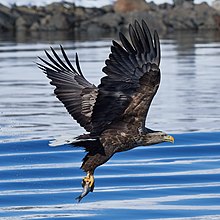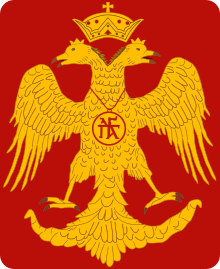User:Wolverine XI/sandbox3
Naming and etymology
[edit]Taxonomy
[edit]Evolution
[edit]Anatomy and physiology
[edit]Size
[edit]The largest extant species of raptor is the Andean condor (Vultur gryphus). This animal can reach a wingspan of 350 cm (140 in) and a body mass of over 16 kg (35 lb).[1][2] At the other end of the scale, with a total length of only 14 to 17 cm (5.5 to 6.7 in) and weight of 30 to 55 g (1.1 to 1.9 oz), the typical falconets are the smallest members.[3] Argentavis magnificens, an eagle-like bird from the Late Miocene, is considered the largest flying bird to ever exist. Its wingspan measured approximately 7 m (23 ft) and it weighed 70 kg (150 lb).[4]
Feathers and moult
[edit]
Birds of prey have a wide array of plumage and feather patterns. Young birds are identified by their dense plumage, which differs greatly from those of adults.[5] Differences in wingspan and tail length suggest adaptations for distinct modes of predation. For example, a short, yet broad wingspan allows for explosive, short-distance movement through canopies of rainforests and other forested habitats. Whereas, wings that acuminate at the tips give a more aerodynamic build. This build enables some bird of prey, like falcons, to dive at the highest speeds recorded for animals.[6]
All birds of prey go through a process called molting, at least once a year.[7]
Beaks
[edit]
Talons
[edit]
Locomotion
[edit]Senses
[edit]
Pathogens
[edit]Distribution and habitat
[edit]
Migration
[edit]Behavior
[edit]Diet and hunting
[edit]
Communication and social structures
[edit]Reproduction
[edit]
Conservation
[edit]Human relations
[edit]In captivity
[edit]
Attacks on humans
[edit]In culture
[edit]
Citations
[edit]- ^ Alarcón, Pablo A. E.; Morales, Juan M.; Donázar, José A.; Sánchez-Zapata, José A.; Hiraldo, Fernando; Lambertucci, Sergio A. (2017-09-13). "Sexual-size dimorphism modulates the trade-off between exploiting food and wind resources in a large avian scavenger". Scientific Reports. 7 (1): 11461. doi:10.1038/s41598-017-11855-0. ISSN 2045-2322.
- ^ Zambrano-Monserrate, Manuel A. (April 2020). "The economic value of the Andean Condor: The national symbol of South America". Journal for Nature Conservation. 54: 125796. doi:10.1016/j.jnc.2020.125796. ISSN 1617-1381.
- ^ Setiyono, J.; Diniarsih, S.; Noske, Richard A.; Budi, N.S. (January 2014). "Large prey for a small predator: Black-thighed Falconet Microhierax fringillarius preying on Black-capped Babbler Pellorneum capistratum". Kukila. 18 (1): 32–36.
- ^ Chatterjee, Sankar; Templin, R. Jack; Campbell, Kenneth E. (2007-07-24). "The aerodynamics of Argentavis, the world's largest flying bird from the Miocene of Argentina". Proceedings of the National Academy of Sciences of the United States of America. 104 (30): 12398–12403. doi:10.1073/pnas.0702040104. ISSN 0027-8424. PMC 1906724. PMID 17609382.
- ^ Forsman 2016, p. Introduction.
- ^ Flyod 1993, p. 9.
- ^ Zuberogoitia, Iñigo; Zabala, Jabi; Martínez, José Enrique (2018-07-01). "Moult in Birds of Prey: A Review of Current Knowledge and Future Challenges for Research". Ardeola. 65 (2): 183. doi:10.13157/arla.65.2.2018.rp1. ISSN 0570-7358.
Sources
[edit]- Tingay, Ruth; Katzner, Todd (2011-01-15). The Eagle Watchers: Observing and Conserving Raptors around the World. Cornell University Press. ISBN 978-0-8014-5814-9.
- Christie, David A.; Ferguson-Lees, James (2010-07-30). Raptors of the World. Bloomsbury Publishing. ISBN 978-1-4081-3550-1.
- Ferguson-Lees, James; Christie, David A. (2020-09-17). Raptors of the World: A Field Guide. Bloomsbury Publishing. ISBN 978-1-4729-8764-8.
- Bildstein, Keith L. (2006). Migrating Raptors of the World: Their Ecology & Conservation. Cornell University Press. ISBN 978-0-8014-4179-0.
- Forsman, Dick (2016-02-25). Flight Identification of Raptors of Europe, North Africa and the Middle East. Bloomsbury Publishing. ISBN 978-1-4729-2555-8.
- Scholz, Floyd (1993). Birds of Prey. Stackpole Books. ISBN 978-0-8117-0242-3.


